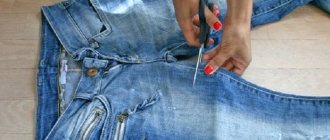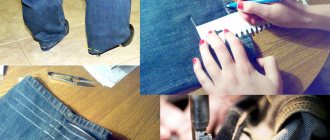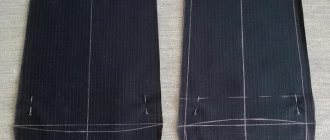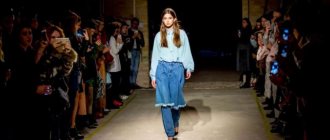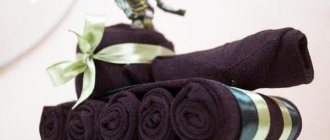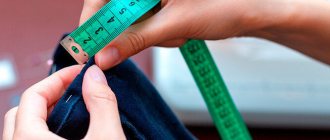Which jeans look fashionable with a cropped hem?
Any pair of jeans can become a fashion accessory if you follow a few simple cutting rules. The table shows the main types of jeans and options for transforming them by shortening the length.
| Jeans type | Type of transformation |
| Flared |
|
| Direct |
|
| Tapered |
|
Achieving a stylish casual effect when cutting jeans depends on the type of fabric they are made from.
You can create a beautiful fringe only from natural rough denim that does not have elastane (or its content is less than 50%). Stretch jeans will look great with the stitching still in place or with a raw hem that has a slightly fluffy, casual look.
More often, to transform jeans, they choose plain models in classic colors (black, blue, light blue). Fringe and various slits on colorful jeans will not look expressive. At the same time, following the trend of the season, jeans with small prints, having a raw hem and contrasting details, are becoming popular.
Preliminary preparation
Before cutting, you need to take measurements:
- Put on your jeans and zip them up.
- Then another person should mark the desired fold line.
- To do this, stand on a flat surface with your legs straight.
- Normal length is the point where the bottom edge touches the floor.
- To determine the optimal zone, you can take a triangle.
- At this point, have an assistant draw a line with chalk on either side.
- Now take off your jeans.
- Measure the distance from the edge of the pant leg to the chalk note.
- Set aside the same distance in a circle on both trouser legs and lay out the fold lines.
All. Further actions will depend on the selected hem method.
Who is the marginal denim style suitable for?
Marginal style in denim suits absolutely everyone, regardless of age, height and gender. The essence of style comes down to convenience and personal worldview. Such people value comfort in clothing and the need to protect the body from the cold.
Marginal denim is very popular among people of all social levels. Things that look sloppy are often made of high-quality and expensive materials. The main element of clothing in a marginal style is plain, faded, torn jeans, with patches and scuffs.
Photos of fashionable and beautiful ripped jeans
And finally, I would like to note - before you start altering new or old jeans, decide on their model.
- Holes in jeans that fit too tightly can lead to a completely unsexy “falling out” and protruding parts of the legs from these holes. This is especially true for ladies with curvy figures. They should take a closer look at straight jeans.
- Straight slits of a vertical structure will make the plumper much slimmer.
- And for thin young ladies, jeans with fairly wide horizontal holes, as well as options with holes in the knee area, will help them visually “gain” a few kilograms.
Experiment and you will certainly be able to create a fashionable and stylish item with spectacular holes.
Source
Necessary tools for cutting jeans
A supply of imagination, a moment of experimentation and a number of available tools will help you cut your jeans at the bottom in a fashionable way:
- manicure scissors;
- tailor's scissors (large stationery scissors);
- ripper;
- chalk (pencil);
- tailor's pins;
- threads;
- tweezers;
- sandpaper (sharpening stone);
- iron;
Preparatory work
When transforming your favorite jeans, your body shape and season trends are taken into account. The most important step when cutting jeans is to accurately determine the desired length of the product.
Preliminary steps to be performed before starting work:
- The style in which cropping is expected is determined. Viewing photos on the Internet and studying the characteristics of your own figure will help you make the right choice.
- Selected jeans are pre-washed. Natural denim shrinks slightly after washing. If you cut off unwashed, worn-in jeans and then wash them, you can get a result that differs from what was originally intended. For example, the length of the product and the length of the fringe will become shorter.
- The necessary tools are being prepared.
- The desired length of the trouser legs is determined in front of the mirror and a mark is made with a pencil or chalk.
How to cut denim at the bottom in a fashionable way? Options and step-by-step description Season trends suggest current solutions for creating fashionable jeans, shorts and breeches.
How to hem jeans at home without cutting the bottom
If you are afraid that the bottom of your trousers will unravel, you don’t have to trim the edges.
Step 1
Turn the pants inside out, try them on, and mark the desired length with chalk.
Step 2
Take it off, straighten it, and make sure that the seams match on the outside and inside. Secure the hem with safety pins.
Step 3
Sew the jeans under the factory seam. The threads should match the color of the fabric so that your stitching is invisible. Lift the fold up and iron it.
Step 4
Sew the pressed fold to the trouser leg with a hidden seam so that the leg does not fall into the resulting “pouch”. Iron it again and wear it with pleasure.
Beautiful with factory stitching preserved
Sometimes the style of clothing does not allow for negligence. In this case, a good solution for creating an original look would be to shorten the length of the jeans while maintaining the stylish factory stitching.
You can cut the bottom of jeans in a fashionable way by following the following procedure:
- The length of the trouser legs is determined and a mark is made with chalk or pencil.
- The line of the new length is combined closely with the factory hem so that a fold is formed on the wrong side, and on the front side the jeans look like they have been processed in a factory. The fold is fixed with tailor's pins and basting is done with thread.
- From the inside, a machine or hand stitch is laid along the basted line.
- Excess fabric is trimmed at a distance of 1.5 cm from the new seam.
- Sections are processed with an overlock or overlock stitch.
- Using an iron, the seams are steamed, the factory hem is straightened down, and the seam cuts are straightened up.
How to make abrasions at a seam
You will need a brush, a spray bottle of water and fabric paints.
- Wet the edges of your pants with water from a spray bottle.
- Mix purple and blue paint and apply with a brush to the machine seam area. Let it dry. To speed up the process, use a hairdryer.
- To imitate abrasion, you need to gather the edges. Take a thread and a needle, make large stitches (about 0.5 cm) at the top and bottom, and gather the fabric into an accordion. They don't have to be even.
- Wet your jeans again with water. Load up some white paint to keep your brush semi-dry. Lightly move along the gathers and hem of the legs.
- Once the paint has dried, you can unravel the stitches. Now the seam is difficult to distinguish from the factory one.
For the length of breeches or shorts
For these purposes, you can choose any out-of-fashion jeans that fit your figure well. For knee-length breeches, both tapered and straight models are suitable. It is good to use stretch and natural cotton jeans at the same time.
Important points when cutting jeans to shorts length:
- for classic and short shorts, it is better to use only natural denim, since elastic fabrics pinch the thigh, which does not look aesthetically pleasing;
- when planning the length, it is better to leave an extra 2 cm and then cut it off if necessary, rather than immediately cutting it too short;
Work order:
- Selecting product length. When planning hems or cuffs, an allowance of approximately 7 cm is left. If fringe is planned, an allowance of at least 2 cm is left. Appropriate markings are applied with a pencil.
- Using sharp scissors, cut to the required length, taking into account allowances.
- The product is being tried on. A decision is made to process the bottom. Perhaps, when trying on, the desire to make a fringe will change to a desire to bend the bottom of the product or make a lapel. Depending on the decision, the length of the shorts or bridge is adjusted.
- The bottom of the product is processed.
Bottom processing options may vary:
- With a lapel. The bottom is turned over twice to the front side of the product, the bend of the desired width is fixed with a steam iron.
- With a hem. The lapel is made inside the product and stitched on a sewing machine or with a hand stitch.
- With fringe. Fringe can be obtained in different ways. You can rub the edges against each other, imitating the motion of hand washing.
You will get a light, neat fringe. Also, by pulling the threads with tweezers, you can get a longer, stylish fringe. This creates a more natural, messy look with a jagged edge. Washing in the machine also gives a good result in creating a fringed edge.
How to lengthen jeans
Our advice will help in situations where the trousers have shrunk after washing, the child has grown, and the trousers have become a little short. You can take it to a studio or save money and increase the length at home.
Wet
If you don’t want to bother with sewing, you can try stretching wet jeans. First you need to wash them.
- Fill the bathtub with water, dissolve one capful of baby shampoo, and stir. The liquid should be warm, never hot. Immerse the jeans in there and let them lie in the soapy solution for half an hour.
- Take it out of the water and wait for the water to drain. Don't twist them. After this, wrap the trousers in a terry towel to make a “roll”. Squeeze the fabric to absorb the water into the towel. Change to dry as needed.
- When most of the liquid has been absorbed, pull the fabric down from the waistband. Don't make sudden movements. After reaching maximum tension, leave to dry in a horizontal position.
Do not miss
- Do not miss
Whether it fits or not: how to stretch jeans at home
Decorative finishing
You can lengthen women's or children's pants by trimming them with fringe, frill, lace - there are many options. Sew the decorative element underneath or over the factory seam. But by betting you can not only increase the length, but also the width. To do this, open the inner seam and lice a triangular piece of fabric.
Adjustment
This method can actually lengthen your trousers by up to 2.5 cm.
- Open the factory seam using sharp scissors and pull out all the threads. This is good to do while the trousers are new and there is no strong contrast.
- Wash, dry as usual, iron the fabric so that there are no creases or folds.
- Try on the desired length of trousers. If you increase the width of the entire hem, you will have to sew a piece of fabric or braid to the edge.
- Machine stitch the fabric and the edge of the trouser leg, try it on again, pin the hem.
- Tuck the fabric, iron it, blind stitch it by hand or machine stitch. You can make a hem using a web tape.
With a jagged raw edge
You can cut jeans in a fashionable way using the trend with an asymmetrical raw edge. A distinctive feature of the method is that the length of the front part of the trouser leg is shorter than the back part. For transformation, both straight and skinny jeans are used.
Work order:
- The bottom factory edge is cut off.
- The product is tried on and the length of the front and back of the legs is determined. Jeans that reveal the ankle look great.
- Markings are applied with a pencil on both legs.
- Using sharp scissors, cut off the edges of the front and back panels of the jeans.
Types of processing of the front part of the trouser leg:
- straight horizontal cut;
- cut at an angle of 45°;
- triangular cutout in the middle of the front;
- torn front cut;
- wavy front cut;
The back part is often cut horizontally. Both parts of the legs are not processed, leaving a slightly fringed edge.
When shortening jeans in this way, you don’t have to be afraid to make an uneven line, since style lies precisely in the deliberately careless cut of the bottom of the legs.
Transparent insert
Any basic jeans can be turned into trendy ones by adding sheer fabric to them. As such a stylish addition, you can use light lace, organza, tulle or other transparent material. It would be great if the texture includes embroidery – another unconditional trend for the 2020 season.
To put this trend into practice, you should first cut the legs to the required length, process the created edge and sew transparent material to it. It is important to ensure the symmetry and accuracy of the work.
With wavy bottom
Cutting jeans to create a wavy hem, as one of the newfangled trends, occupies a leading position.
Visually, such an edge looks like an alternation of the main fabric of the trouser leg with loose gaps that are filled with horizontal white denim threads.
Through this alternation, a stylish effect of a torn, careless bottom is created. You can make only one loose section with elongated threads in the middle of the front of the trouser leg, you can alternate. It is not recommended to make too narrow gaps between loose areas. It is optimal to leave 3-4 cm.
Execution order:
- The length of the jeans is determined. The length of the front and back panels of the trouser legs may be different. To do this, follow the same steps as for obtaining jeans with an uneven raw edge. Markings are made with chalk or pencil.
- Excess edges are cut off with sharp scissors.
- The distances between the loose spaces are marked. The width and height of the spaces with elongated threads are determined. Marks are made with a pencil.
- At the designated intervals for spaces with elongated threads, 3-4 horizontal parallel cuts are made at a distance of 1 cm. Small parallel ribbon-like strips are obtained. From them, using tweezers, the main (vertical) threads are pulled out. As a result, there should be gaps filled only with white horizontal denim threads.
- Washing your jeans will give a natural, casual effect.
With fluffy short fringe
Absolutely any jeans are suitable for alteration, including flared jeans and models with elastane.
The process of doing the work is very simple. The main thing is to outline the desired length, leave an allowance (1-2 cm), trim off excess edges with scissors and make a small fringe using one of the following methods:
- Rub the slices against each other, imitating the motion of hand washing.
- Using a thick needle, tweezers or nail scissors, pull out the main horizontal threads until the fringe reaches the desired length.
- Rub the sections with pumice, a grindstone or sandpaper to obtain a short, fluffy fringe.
- Wash the item in the washing machine to obtain a natural, classic fringed edge.
- Sew finished fringe in a contrasting color along the edge.
With long fringe
Stylists suggest cutting jeans at the bottom in a fashionable way in the form of a hem with a length of fringe to create a street look. For work, jeans made from natural denim are chosen. The fringe on these jeans will be perfect.
The procedure is as follows:
- The length of the trouser legs and the length of the fringe are determined. The corresponding markings are applied to the trouser legs with a pencil or chalk.
- The edge is cut with scissors, taking into account the allowance for the fringe.
- The fringed cloth is cut into vertical strips, each approximately 1 cm wide.
- Using tweezers or a thick needle, horizontal threads are pulled out of the strips. There should be long free threads of vertical rows.
- The fringed edge can be combed, tied into tassels, or tousled with sandpaper.
Despite the variety of fashionable, branded designer jeans, everyone can create a unique pair for themselves by stylishly cutting the hem and bringing their unique look to life.
Article design: Vladimir the Great
Classic move
If you want to give your regular denim an instant upgrade, you can simply add a stylish 7/8 length mark to it. To do this, you should measure the hem to the ankle.
- To begin, draw a straight line with chalk or soap, which will indicate the cutting level of the trouser legs.
- Then take scissors and remove the unnecessary part.
- Next, take a needle and remove the cross threads.
- After that, find sandpaper and sand the edge of the cut.
- Now you need to give the result of creativity a little accuracy (if desired). To do this, take scissors and cut off the threads that exceed the desired length.
- The final touch is to grate the fringe of the trouser legs.
